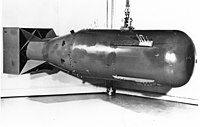
Photo from wikipedia
Unexploded nuclear bombs still lie off American coasts, embedded in swamps, or down on the seabed. These are just a few examples of America’s 32, officially recognized “Broken Arrows”—the Pentagon’s… Click to show full abstract
Unexploded nuclear bombs still lie off American coasts, embedded in swamps, or down on the seabed. These are just a few examples of America’s 32, officially recognized “Broken Arrows”—the Pentagon’s terminology for the unintentional launches, detonations, thefts, or losses of US nuclear weapons. (Technically speaking, the Pentagon defines Broken Arrows as only the worst types of accidents and puts some similar accidents into categories such as “Bent Spear” and “Empty Quiver,” but in common parlance they are generally all lumped together as Broken Arrows.) In a vein closely related to these near-misses with disaster, there was the 1983 NATO “Able Archer” war game—a nuclear exercise that was too realistic, causing the leaders of the Soviet Union to go to high alert and possibly bringing the world to the brink of nuclear war. The reasons why one should be concerned about such incidents is obvious. But the world’s close calls are not limited to the world of nuclear weapons. What happened at Fukushima, Japan, in 2011—one of the world’s best-known nuclear accidents—could correctly be called a “near-miss;” but for luck, spent fuel in the plant’s storage pool could have boiled dry and caught fire, spewing even more radiation than the power plant’s three melted reactor cores emitted, with truly dire results. Because there have been similar almost-catastrophes across our coverage areas, we’ve devoted this special issue to near-misses, close calls, and early warnings, focusing it on the lessons humanity can learn from these narrow escapes. In this issue, Eric Schlosser—the author of Command and Control: Nuclear Weapons, the Damascus Accident, and the Illusion of Safety— explains why the actual number of Broken Arrows is probably in the hundreds, rather than the official figure of 32. He also shares some declassified documents acquired under the Freedom of Information Act that contain information about accidents and incidents that shocked nuclear weapons development and safety engineers at Sandia National Laboratories. Schlosser says these and other declassified reports show that no system for safeguarding nuclear weapons will ever be 100-percent effective, and that the United States (and other nuclear weapons nations, which have their own Broken Arrows) can never completely eliminate the potential for a catastrophic nuclear error. In the article “Able Archer: How close of a call was it?” Thomas Fraise and Kjølv Egeland—experts with the Nuclear Knowledges program at the Center for International Studies in Paris—delve into just how close the superpowers came to blows, because some Soviet leaders feared that a NATO military exercise was a ruse meant to disguise a NATO attack. Lest readers think that such close calls are limited to the Cold War era, technology policy expert Kris Shrishak describes how poorly designed navigation apps employing artificial intelligence led users into greater danger during the 2017 wildfires in California. Technically, the app was not wrong: It was designed to identify and suggest the quickest route to a destination, and one of the criteria it used was how crowded roads are. A street everyone has fled due to an inferno would certainly be devoid of vehicles. There is a silver lining to close calls: Human beings can learn from them and avoid their recurrence. As Susan Solomon points out in her interview for this issue, the planet had a climate change near-miss when the hole in the ozone layer threatened to become so large that, in her words, “by the year 2050 there pretty much would have been an ozone hole everywhere over the whole planet. It would have been just one giant doughnut hole— with no doughnut.” Fortunately, due to science, industry, good policy making, and international cooperation, the culprits—chlorofluorocarbons, or CFCs—were eliminated. The 1989 Montreal Protocol that banned CFCs is probably the best example of international cooperation to resolve
Journal Title: Bulletin of the Atomic Scientists
Year Published: 2023
Link to full text (if available)
Share on Social Media: Sign Up to like & get
recommendations!